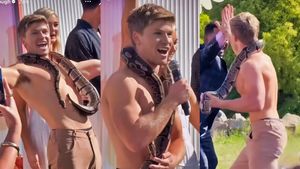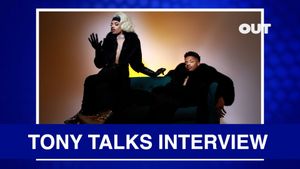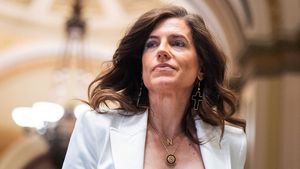
It took a long time for Hollywood to call a spade a spade. Then it took even longer for positive representation, so get prepared for weak but psychotic murderers and the like. Now that it's all out in the open, the hide-and-seek aspects of these old film characters seem like risque fun. Back then, for those in the know, there was nothing ambiguous here -- like a big wink from Hollywood.
John "Plato" Crawford (Sal Mineo), Rebel Without a Cause, 1955
In the tribute montage above (which includes some beefcake of Mineo for good measure) it's hard to see how people didn't understand that Plato was, well, in love with James Dean's character. And Dean is doing nothing to discourage it. Just follow Mineo's eyes. The mirror on his locker, with the photo of Alan Ladd, are like giant hairpins dropping.
-- C.H.
Luz (Mercedes McCambridge), Giant, 1956
OK, first of all, her name is Luz. Get it? Plus
Giant gets some kind of an award for the most gay and bisexual actors ever in one film: James Dean, Rock Hudson, Sal Mineo, Earl Holliman, and while Mercedes never personally came out, she played the most fiercely dykey roles on-screen to perfection. -- C.H.
Jo (Barbara Stanwyck), Walk on the Wild Side, 1966
Even the ferociously closeted actress Barbara Stanwyck admitted that her character, the madam of the bordello, Jo Courtney, is a lesbian. And in the spooky way that only Hollywood can create, the love interest/prostitute is Capucine, one of the most beautiful but icily sexless women to have graced the silver screen. Stanwyck smacks Capucine around some, which is the equivalent at the time of hot lesbian sex, at least in the male film creator's eyes. Don't miss the very hot Jane Fonda as a baby whore and Anne Baxter as a Mexican.
-- C.H.
Dill Harris (John Megna) and Scout (Mary Badham), To Kill a Mockingbird, 1962
I would love to have been on the set of this film when the director, Robert Mulligan, told John Megna, the actor playing Dill, to swish it up somewhat. Megna actually nails it without a lot of fuss. Dill Harris is based on Truman Capote, author Harper Lee's childhood friend. Lee later helped Truman with his work on
In Cold Blood. That the Harper character is named Scout and has a haircut that looks as it was done with an egg beater is sophisticated gender role-play for the time. -- C.H.
Brandon (John Dall) and Phillip (Farley Granger) Rope, 1948
Alfred Hitchcock was fascinated by gay and lesbian characters, and there are sly and not so sly references in many of his films.
Rope is fairly overt. The movie is based on a play, which was based on the the true story of Nathan Leopold and Richard Loeb, who murdered 14-year-old Bobby Franks in Chicago in 1924. This time bi actor Farley Granger gets to be smacked around some for being hysterical and nelly, which is definitely code for gay. But the biggest whiff of lavender is that two young well-dressed male roommates are throwing an odd dinner-cocktail party hybrid. Who does that? James Stewart's Rupert Cadell may or may not be gay in intention, but if the original casting choice of Ray Milland had played the role we would have been much more likely to see him as gay. -- C.H.
Phillip Vandamm (James Mason) and Leonard (Martin Landau), North by Northwest, 1959
In another gay-inclusive Hitchcock classic, suave villain Phillip Vandamm has a thing going with Eve Kendall (Eva Marie Saint), who's actually an American spy trying to find out how he's exporting secrets to our Cold War-era enemies. He also may have a thing going with his devoted "right hand," Leonard, or at least Leonard would like that to be the case. Leonard is suspicious of Eve, leading Vandamm to say, "I think you're jealous." "Call it my woman's intuition," Leonard responds. He's undoubtedly jealous but he's also on to her, and he ends up pursuing Eve and the film's reluctant hero, Roger Thornhill (Cary Grant), in a climactic chase over Mount Rushmore. --
T.R.
Joel Cairo (Peter Lorre), The Maltese Falcon, 1941
The effete, curly-haired, heavily perfumed Joel Cairo is among the shady characters seeking the priceless title statuette; detective Sam Spade (Humphrey Bogart) goes along with the quest in order to find out who killed his business partner. Cairo was clearly gay in the 1930 Dashiell Hammett novel on which the film is based; movies of the era couldn't be quite so overt, but Lorre's Cairo is so effeminate that he fits a certain stereotype of a gay man. Also, as
The Peter Lorre Companion notes, he suggestively fondles an umbrella handle and gets his hand on Spade's posterior briefly. Film experts have also observed that Kasper Gutman (Sydney Greenstreet) and his "gunsel," Wilmer (Elisha Cook Jr.), seem to be a couple. -- T.R.
Mrs. Danvers (Judith Anderson), Rebecca, 1940
In Hitchcock's first U.S. release, soon after British aristocrat Maxim de Winter (Laurence Olivier) brings his new bride (Joan Fontaine) home to his great estate Manderley, we learn that Mrs. Danvers, the housekeeper, "adored Rebecca," Maxim's now-deceased first wife. That point is driven home as "Danny" fondles Rebecca's lingerie -- "Did you ever see anything so delicate?" she tells Fontaine's character. "Look, you can see my hand through it!" She resents the presence of the second Mrs. De Winter ("Even in the same dress you couldn't compare") and does all she can to get rid of the new wife, and she also fondly remembers brushing Rebecca's hair and laughing with her at the idea that Rebecca could ever love any man. Every housekeeper is that devoted, right? --
T.R.
Bruno (Robert Walker), Strangers on a Train, 1951
In this Hitchcock film about a plot to trade murders , Farley Granger plays the hot straight guy that the unctuous Bruno, played by Robert Walker, inveigles into his lurid plan. Bruno's nelliness would have been enough -- plus he practically drools on Farley's extra-wide lapels -- but Hitchcock wants no ambiguity, so two-tone spectator shoes and flashy dressing gowns are used for the less-than-perceptive.
-- C.H.
Addison DeWitt (George Sanders), All About Eve, 1950
One of the greatest pleasures in a film with many is Sanders's performance as drama critic Addison DeWitt, with his pitch-perfect delivery of Joseph L. Mankiewicz's sardonic dialogue: "To those of you who do not read, attend the theater, listen to unsponsored radio programs, or know anything of the world in which you live, it is perhaps necessary to introduce myself," he says in a voice-over as the movie begins. Addison is the ultimate condescending snob, described by one character as a "venomous fishwife"; in a less censored time, that would be "bitchy queen." Along with his high-toned manner of speaking, his impeccable clothing and cigarette holder signal gayness, and he seems interested in women only to make them stars. "That I should want you at all suddenly strikes me as the height of improbability," he says to the titular Eve (Anne Baxter). Addison is said to have been based on one of two acerbic New York critics of the 20th century, George Jean Nathan (apparently straight) or Alexander Woollcott, who was gay. Woollcott inspired other film portrayals as well; read on. --
T.R.
Waldo Lydecker (Clifton Webb), Laura, 1944
Another character based on Woollcott, Waldo Lydecker is just as bitchy as Addison DeWitt and a lot more queeny. A powerful columnist and radio commentator, he's helped the film's title character to rise in the advertising business and he's obsessed with her, but there are several indicators that his obsession isn't of a sexual nature -- those interests lie elsewhere. Key signs: the elaborately decorated apartment ("It's lavish, but I call it home"), the walking stick, the perfection in dress and diction, and the fact that he answers questions from a hunky detective while in the bathtub. Played unforgettably by gay actor Clifton Webb, Waldo is the most fascinating character in the film, and he'd agree with that assessment. "In my case, self-absorption is completely justified," he says at one point. "I have never discovered any other subject quite so worthy of my attention." --
T.R.
Sheridan Whiteside (Monty Woolley), The Man Who Came to Dinner, 1942
Is it a sign of our culture's dumbing-down or just its fragmentation that we can't think of any contemporary figure who'd inspire three fictional portrayals? Yet another character based on Woollcott is famed critic Sheridan Whiteside, a sophisticated New Yorker who gets stuck at a bourgeois Ohio couple's home when he slips on the ice and breaks his leg while visiting. In this film adaptation of the George S. Kaufman-Moss Hart play, "Sherry" (played by gay actor Monty Woolley, a pal of Cole Porter's) make lifes miserable for the couple, his nurse, and his secretary, and encourages his hosts' son and daughter to rebel. Like Addison DeWitt and Waldo Lydecker, he does not lack for ego; "Is there a man in the world who suffers as I do from the gross inadequacies of the human race?" he wonders. Also like them, he has an effete manner and acid tongue that mark him as a certain type of gay man. And when a local journalist asks him how he thinks Ohio women stack up, he responds, "I've never gone in for stacking women up, so I really can't say." Whiteside entertains some showbiz visitors during his convalescence. They include playwright Beverly Carlton, who talks about seducing South Seas maidens but, as played by Reginald Gardiner, reads as pretty gay, and after all, the character is based on Noel Coward. Then there's comedian Banjo (Jimmy Durante), inspired by Harpo Marx,
with whom Woollcott was in love. Whether Harpo reciprocated is subject to debate. -- T.R.



















































































